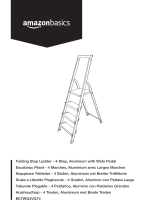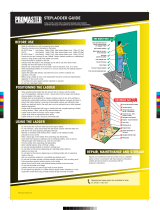Page is loading ...

4
Reparatur und Wartung
Bitte vergessen Sie nie, dass eine regelmäßige Wartung und Reinigung zur Sicherheit und Erhaltung Ihrer Teleskopleiter beiträgt. Reparaturen und
Wartungsarbeiten an der Leiter müssen von einer sachkundigen Person und entsprechend den Anleitungen des Herstellers durchgeführt werden.
Leitern sollten immer in Übereinstimmung mit den Anleitungen des Herstellers gelagert werden(siehe Abschnitt „Pfl ege und Lagerung“).
Pfl ege und Lagerung
Nur mit Wasser reinigen, nie mit scharfen Reinigungsmitteln. Anschließend mit einem trockenen Tuch trocken wischen. Lagern Sie die Leiter immer
trocken und sauber in einem temperierten Raum.
Hinweise zur Entsorgung
Verpackung und Artikel bitte umweltgerecht und sortenrein entsorgen!
Entsorgen Sie den Artikel über einen zugelassenen Entsorgungsbetrieb oder über Ihre kommunale Gemeindeverwaltung. Beachten Sie die aktuell
geltenden Vorschriften.
Peddinghaus Handwerkzeuge
In der Graslake 35 – 58332 Schwelm
Germany
13
Using the ladder
a) Do not exceed the maximum total load : 150 kg.
b) Do not overreach. User should keep their belt buckle (navel) inside the stiles and both feet on the same rung throughout the task.
c) Do not step off a leaning ladder at a higher level without additional security, such as tying off or use of a suitable stability device.
d) Do not stand on the top three rungs of a leaning ladder.
e) Ladders should only be used for light work of short duration.
f ) Use non-conductive ladders for unavoidable live electrical work.
g) Do not use the ladder outside in adverse weather conditions, such as strong wind.
h) Take precautions against children playing on the ladder.
i ) Secure doors (not fi re exits) and windows where possible in the work area.
j ) Face the ladder when ascending and descending.
k) Keep a secure grip on the ladder when ascending and descending.
l ) Do not use the ladder as a bridge.
m) Wear suitable footwear when climbing a ladder.
n) Avoid excessive side loadings e.g. drilling brick and concrete.
o) Do not spend long periods on a ladder without regular breaks (tiredness is a risk).
p) Leaning ladders used for access to a higher level should be extended at least 1 m above the landing point.
q) Equipment carried while using a ladder should be light and easy to handle.
r) Avoid work that imposes a sideways load on standing ladders, such as side-on drilling through solid materials (e.g. brick or concrete).
s) Maintain a handhold whilst working from a ladder or take additional safety precautions if you cannot.
Repairs and Maintenance
a) Repairs and maintenance shall be carried out by a competent person. Do not use a damaged ladder.
b) Keep the ladder and its hinges clean and free of all foreign materials that could damage ladder functions. Clean the ladder before closing it after
each use.
c) Store ladder in safe and dry place.
Storage
During transport to or from the place of storage, the ladder must be secured against sliding, impacting and falling off.
The ladder must be protected against the weather.
Never store materials on ladder.
SAVE THESE INSTRUCTIONS
Mob Outillage
Rue Bergognon -425002 Le Chambon Feugerolles
France
Peddinghaus Handwerkzeuge
In der Graslake 35 – 58332 Schwelm
Germany

12
Folding instructions
1) Put one foot on the treadle located below the lowest rung
2) Push to the side (the ladder is unlocked)
3) Tilt the treadle forward. You can now put your foot back on the fl oor
4) Use both hands to help the rungs down
5) For transport, secure the Velcro strap.
Check list before use
Is the sticker instructions in place?
Is the ladder free of damage?
Are all the rivets in place ?
Are the end caps of the feet free of damage?
Is the ladder clean ?
Is the opening doing well ?
Is the ladder stable ?
Is the ladder free of corrosion ?
Before use
a) Ensure that you are fi t enough to use a ladder. Certain medical conditions or medication, alcohol or drug abuse could make ladder use unsafe.
b) When transporting ladders on roof bars or in a truck, ensure they are suitably placed to prevent damage.
c) Inspect the ladder after delivery and before fi rst use to confi rm condition and operation of all parts.
d) Visually check the ladder is not damaged and is safe to use at the start of each working day when the ladder is to be used.
e) For professional users regular periodic inspection is required.
f) Ensure the ladder is suitable for the task.
g) Do not use a damaged ladder.
h) Remove any contamination from the ladder, such as wet paint, mud, oil or snow.
i) Before using a ladder at work a risk assessment should be carried out respecting the legislation in the country of use.
Positioning and opening the ladder
a) Ladder shall be erected at the correct position, such as the correct angle for a leaning ladder (angle of inclination approximately 1:4) with the rungs
level and complete opening of a standing ladder.
b) Locking devices shall be fully secured before use.
c) Ladder shall be on an even, level and unmoveable base.
d) Leaning ladder should lean against a fl at non-fragile surface and should be secured before use, e.g. tied or use of a suitable stability device.
e) Ladder shall never be repositioned from above.
f) When positioning the ladder take into account risk of collision with the ladder e.g. from pedestrians, vehicles or doors. Secure doors (not fi re exists)
and windows where possible in the work area.
g) Identify any electrical risks in the work area, such as overhead lines or other exposed electrical equipment.
h) Ladder shall be stood on its feet, not the rungs.
i) Ladders shall not be positioned on slippery surfaces (such as ice, shiny surfaces or signifi cantly contaminated solid surfaces) unless additional
effective measures are taken to prevent the ladder slipping or ensuring contaminated surfaces are suffi ciently clean.
5
FR
Notice d’utilisation
Lire attentivement cette notice.
Echelle télescopique en aluminium
Hauteur dépliée : 4 m
Poids : 14kg
Ouverture - mode d’emploi
1) Détacher la sangle
2) Caler l’échelle avec le pied
3) Elever les barreaux les uns après les autres jusqu’au clic
4) Le bas de l’échelle doit être placé à 1m du mur si elle est déployée complètement (4m)
5) En cas de déploiement partiel (par exemple à 2m ou 3m), déployer les barreaux d’en bas pour laisser les
barreaux non utilisés en haut de l’échelle. Ne surtout pas faire l’inverse.
Fermeture - mode d’emploi
1) Poser le pied sur la commande
2) Pousser sur le côté (l’échelle est déverrouillée)
3) Incliner vers l’avant - vous pouvez reposer le pied par terre
4) Vous avez les mains libres pour ramener les barreaux en position fermée
5) Pour le transport, attacher la sangle grâce au scratch.
/



